Pad Thai (Phat Thai)
May 13, 2013 in noodles, thai, thailand, phat tai, asian, epicurious, recipe, pad thai. Read the original on: Tiny Urban Kitchen
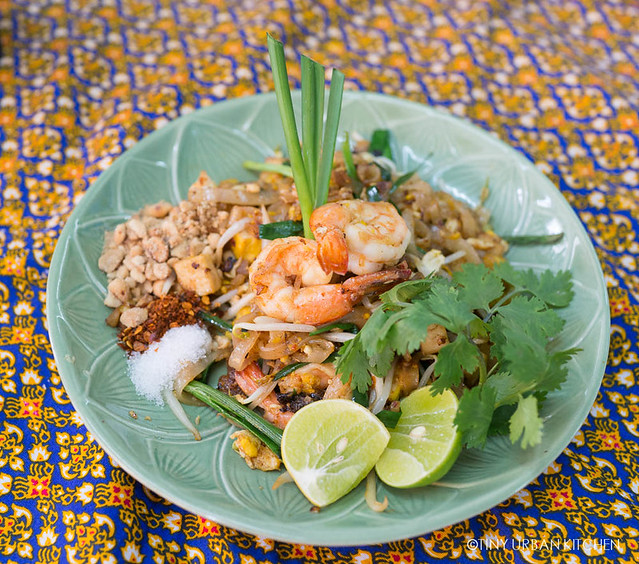
This is the third of four dishes that I learned to make during my 4-hour cooking class at BaiPai Cooking School in Bangkok, Thailand. I also learned how to make this at my cooking class at Somphong Thai Cooking School. This is a mini-series that's part of a larger Thailand! travel series of my eats in Bangkok. Scroll to the bottom of the post to see other posts in this series.
It was one of the first things I asked during our cooking class in Bangkok.
"Do Thai people eat Pad Thai a lot?"
It's such a common dish here in the U.S. We see it in every Thai restaurant, from the cheap chains to the higher end ones. We even see it in Chinese restaurants sometimes. Do Thai people actually eat this dish? Or is it like the Thai version of "Chinese" crab rangoons, chop suey, and egg foo young?
Without hesitation, our instructor Nok replied, "Absolutely. I love this dish and eat it all the time. We bring it to potlucks, we eat it on the street, we make it at home. It is probably the dish we eat the most."
I learned how to make this dish twice while in Thailand. Both cooking classes offered it as one of the four courses. I also ate it numerous times while I was in Thailand.
I quickly learned that Pad Thai in Thailand is quite different from the Pad Thai in the US. I was surprised how similar the recipes from the two classes were (virtually identical), and how different (and so much better!) these were compared to the Pad Thai I'd eaten in America.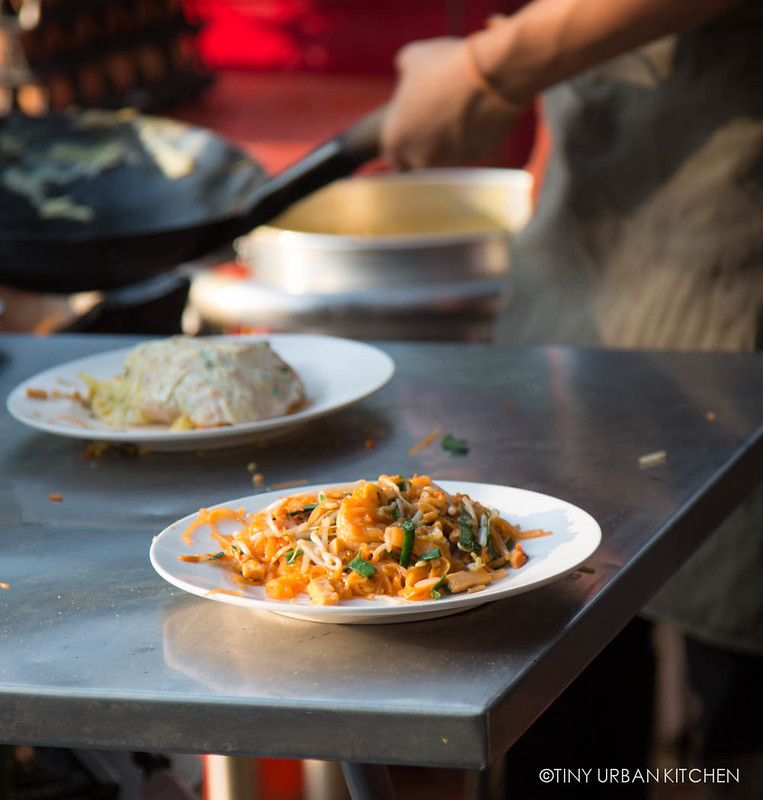 Pad Thai from Thip Samai, arguably one of the best Pad Thai places in Bangkok
Pad Thai from Thip Samai, arguably one of the best Pad Thai places in Bangkok
There are several ingredients in authentic Bangkok street pad Thai that I don't typically see in my local US Thai restaurant: Chinese chives (or garlic chives), dried tofu (or bean curd), and salted turnips. Tamarind is also an essential ingredient that's used in the sauce base. Many recipes use lime juice or vinegar as a substitute, which really creates an all-together different tasting beast.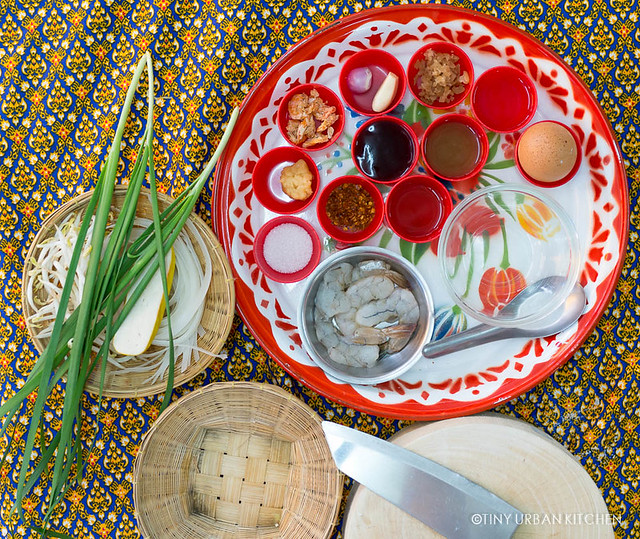
Pad Thai is one of those dishes where it's really important to make sure you have all your mis en place perfectly ready to go. There is a sizable amount of prep, but the actual cooking is fast, and if you're not ready with your ingredients, you could easily mess up the execution.
Here Koy from Somphong Cooking School demonstrates to a class of interested students just how quick the whole process is.
Once you've made sure to chop, dice, de-vein, and soak all necessary ingredients, make your sauce. It's pretty simple - just mix together chili powder, palm sugar, white sugar, fish sauce, tamarind juice (or tamarind paste + vinegar), and (optionally) oyster sauce. I say optionally because oyster sauce was present in one cooking school's recipe but not the other one.
Just a side note about tamarind. Tamarind is a pod-like fruit grown in tropical areas (see left photo below). It's got a very tart flavor and i9s often used in Thai recipes.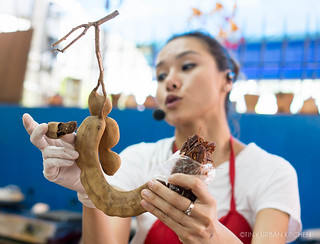
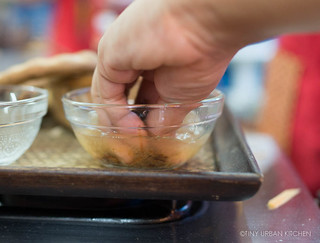
In Thailand, we bought fresh "wet" tamarind from the market (what she's holding in her left hand). Typically, you take this pulp, add it to hot water, and mash it up with your hands (see photo on right). After letting it steep for awhile, you can strain it and use the tamarind juice. I did a bit of searching, and it looks like you can purchase wet tamarind online if you can't find it in your market (though I'm pretty sure I've seen at least tamarind pods at Asian markets).
If you want to take a short cut, you can purchase tamarind paste in a jar. In this case, you can use the paste directly. In our recipe, we "diluted" the paste up with some added vinegar.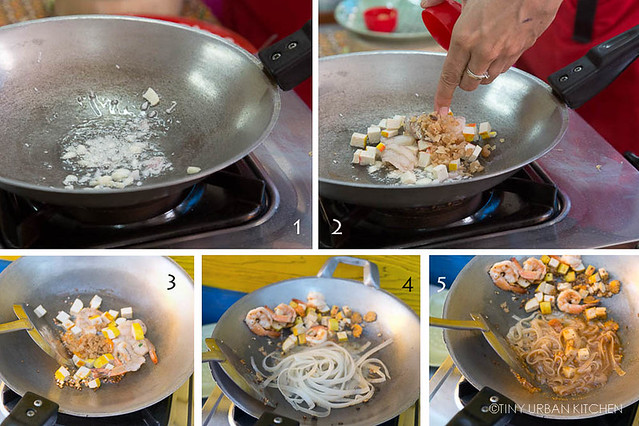
Once you're pretty certain you've got everything ready to go, it's time to get started!
(1) Add the aromatics (garlic, shallots) to your wok and heat until fragrant.
(2) Add the dried bean curd, salted radish, and shrimp and
(3) stir fry until the shrimp is cooked.
(4) Push the shrimp aside (or safer yet, remove the shrimp from the wok), and add the noodles and water (or stock). Stir fry until noodles are soft.
(5) Add the pad Thai sauce that you just made and stir well, allowing the noodles to absorb the liquid.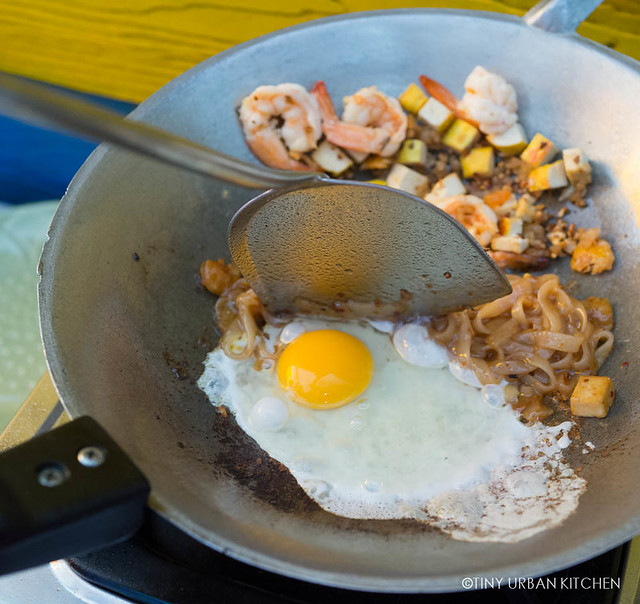
Now push everything aside to make room to fry the egg!
There are two options for what you can do with the egg. You can either break it up like the traditional way and mix it throughout. Or you can make it into a thin omelette with the pad Thai inside. Below I've shown both methods.
Traditional
Scramble the eggs inside the wok, breaking up the egg into small pieces. Add the Chinese chives and bean sprouts and stir everything together until cooked.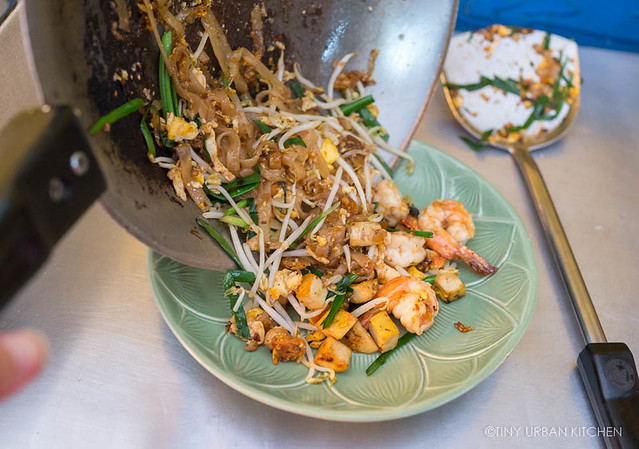
Transfer to a serving dish (yum!).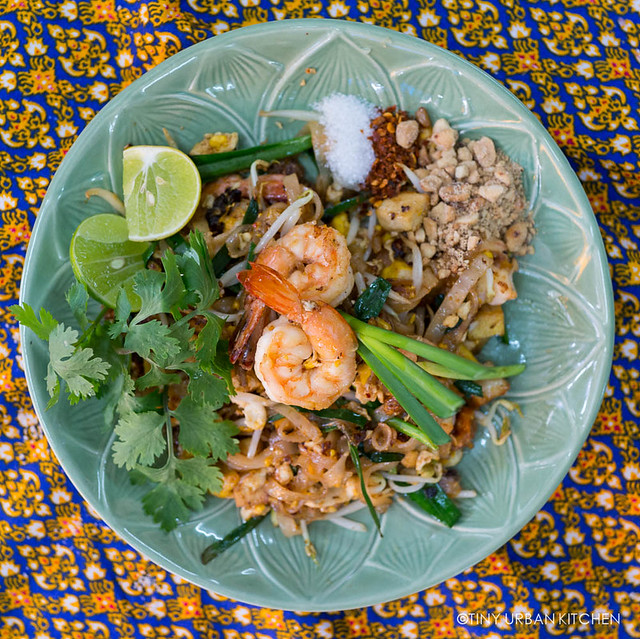
For decorative purposes, place the shrimp on top. Around the plate, add chopped cilantro, lime wedges, and a small spoonful each of sugar, chili powder, and peanuts. These three accompaniments allow diners to choose how sweet, spicy, or "peanuty" they want to make their Pad Thai.
Omelette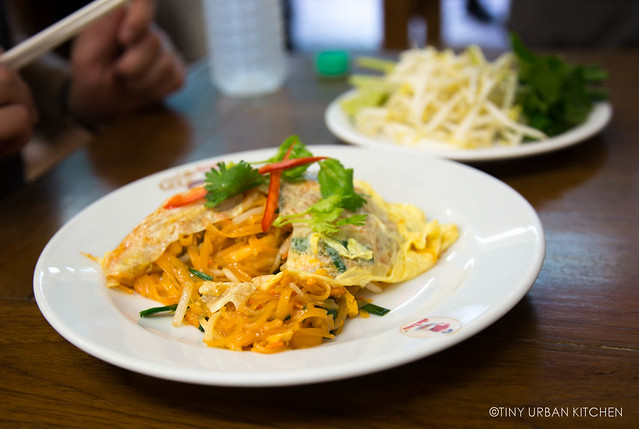
The omelette method takes the egg portion of the Pad Thai and wraps it around the Pad Thai noodles. This technique takes more skill, since it requires you to make a super thin omelette on the wok and then successfully wrap it around the noodles without it breaking!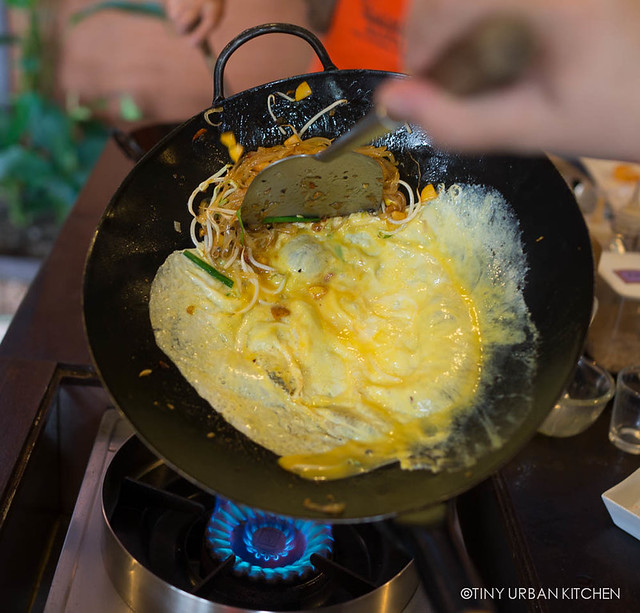
First, you will need to add the Chinese chives and bean sprouts to the noodle mixture and stir fry until cooked. Once the noodles are done, push the cooked noodles to the side of the wok and add one egg (already beaten). Spread it out on the wok as thinly as possible by picking up the wok and turning it, using gravity to spread the egg.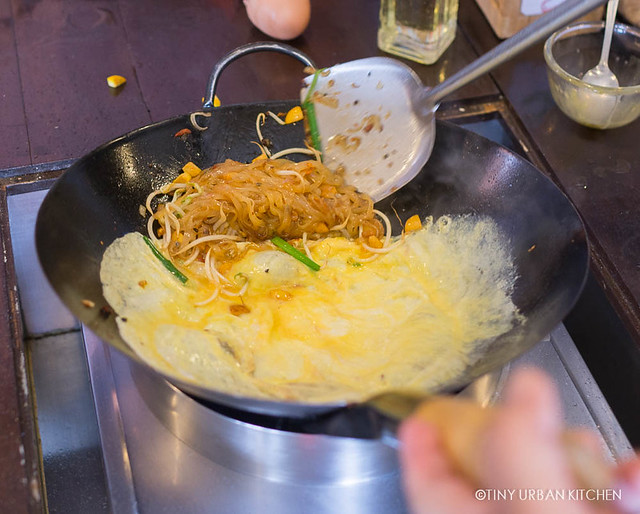
Once the egg is cooked, wrap it around the Pad Thai like a burrito. This is most easily done by rolling the noodle pile (which you have tried to mold into the shape of your final product) back over the egg sheet, and then wrapping the edges around. This obviously takes some skill. If it's your first time making pad Thai, I might recommend trying the normal version first!
Serve with the same accompaniments (peanuts, chili, sugar, limes), but on the side.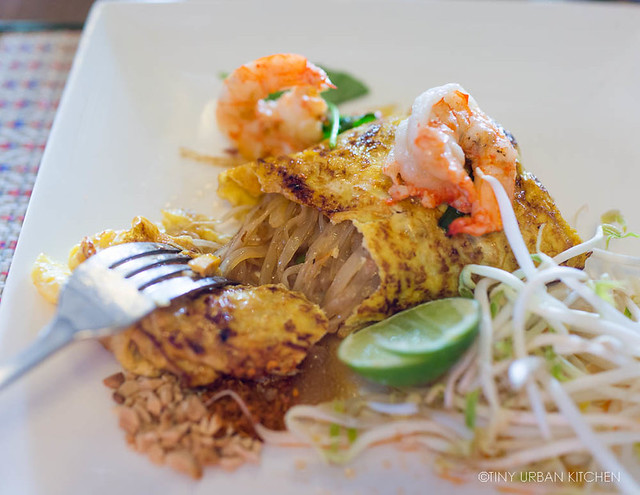
Yum!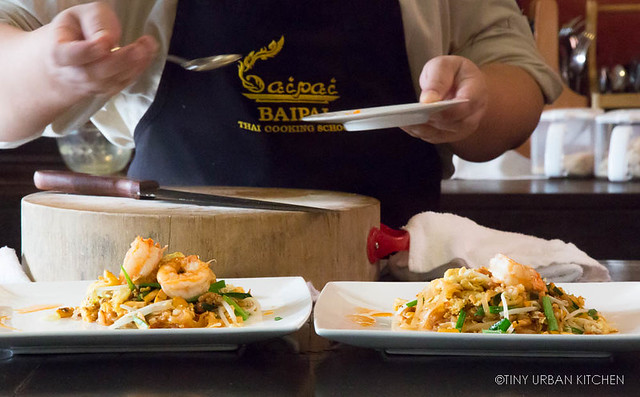
A few notes
I learned how to make this dish twice from two different cooking schools. Although most aspects of the recipes were very, very similar, there were a few difference that highlight parts of the recipe that are probably flexible.
1. Aromatics: one recipe used just shallots while another one used garlic and shallots. My guess is that either works, and you may even be able to substitute onions or even scallions if you in a bind.
2. Pad Thai Sauce: one recipe included oyster sauce while another did not. Traditionally, tamarind is used to contribute tartness to the recipe. This can come in different forms, such as tamarind juice or tamarind paste. At the first school, tamarind juice was used. At thesecond cooking school, tamarind paste was used, but then vinegar was also added, perhaps to give it some liquid and tartness?
3. Technique: As I mentioned before, this dish moves quickly. Our teacher at Somphong was skilled, and therefore was able to make everything in one pot by just quickly pushing stuff to the edge of the wok. At BaiPai, they recommended removing the shrimp at the beginning of the cooking process and then adding it back in later. For us less experienced cooks, I think that's a good idea because overcooked shrimp does not taste good at all.
4. The Wok: Though both classes used a simple wok to make this dish, some had said that a flat bottom pan is easier because it allows you to push parts of the dish aside without having them fall back into the pan. In Thailand, it seems like the most famous street vendors use a traditional wok, and they always just make the dishes to order. This is not a great dish to make in bulk.
I was thrilled to discover how accessible this dish was. I think the hardest part is obtaining all the authentic ingredients. In Thailand, we were able to get fresh tamarind and fresh rice noodles, which are harder to access in a normal supermarket here in the US.
I think most of these ingredients are available in Asian supermarkets, so I'm really excited to try making this soon at home in the US. I'll let you know how it goes!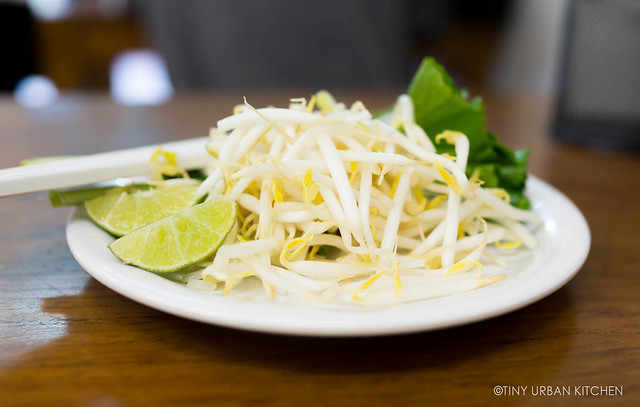
Pad Thai
serves 1
Ingredients
1 T cooking oil
1/2 T minced garlic
1/2 T minced shallots
4-6 shrimp, shelled and deveined
1 T salted Chinese radish, chopped
1 T dried shrimp
1 T dried bean curd, cut into cubes
1 cup rice noodles (if using dried, soak in hot water first until soft)
1 T water
Pad Thai Sauce (see below)
1 egg
1/2 cup Chinese chives (cut into 2 cm strips)
1/2 cup bean sprouts
Accompaniments
2 T roasted peanuts, crushed
1 bunch of cilantro, chopped
1 lime, cut into wedges
1 tsp chili powder
1tsp sugar
Pad Thai Sauce
1 tsp chili powder
1/2 T white sugar
1/2 T palm sugar
1 T fish sauce
1 T tamarind juice or [4 tsp tamarind paste + 1 tsp vinegar]
1 T oyster sauce (optional)
If the rice noodles are dry, soak them in hot water for about 20 minutes until soft. Meanwhile, prepare the Pad Thai sauce by mixing together all of the ingredients in a small cup. Set aside.
In a wok over medium heat, cook garlic and shallots until fragrant, about 2-3 minutes. Add the shrimp, salted Chinese radish, dried shrimp and dried bean curd. Stir fry until prawns are cooked.
Add the noodles and the water and cook until the noodles are soft.
Ad the Pad Thai sauce and mix well. Cook until the sauce is no longer liquidy.
Push the noodles to one side and add an egg.
Traditional Method: if you want to mix the egg up, scramble the egg and cook it. Once it's done, add the bean sprouts and Chinese chives. Stir everything together until cooked.
Transfer to a serving dish, and garnish with accompaniments such as cut lime wedges, sugar, chili powder, crushed peanuts, and cilantro.
Serve!
This is the fiftheenth post in the Thailand! travel series of my eats in Bangkok. Other posts include:
Eats!
Thip Samai, Best Pad Thai in Bangkok?
Raan Jay Fai, Best Drunken Noodle in Bangkok
Street Foods of Bangkok, Part I
Street Foods of Bangkok, Part II
Fun Fruits in Thailand
Cool Experiences
Maeklong Railway Market
Floating Markets (Damnoen Saduak)
Cooking Classes + Recipes
Somphong Thai Cooking School
Som Tam (Papaya Salad)
Thai Panaeng Curry Chicken
Bananas In Golden Syrup
BaiPai Thai Cooking School
Golden Bags
Larb Gail (Laap Gai)
©2009-2012 Tiny Urban Kitchen All Rights Reserved
Read the original on: Tiny Urban Kitchen
Tiny Urban Kitchen, Jennifer Che
Tiny Urban Kitchen is based out Jen's kitchen in Cambridge and features Boston eats, Jen's cooking experiments (she was a chemist, after all), and food from all her travels.




